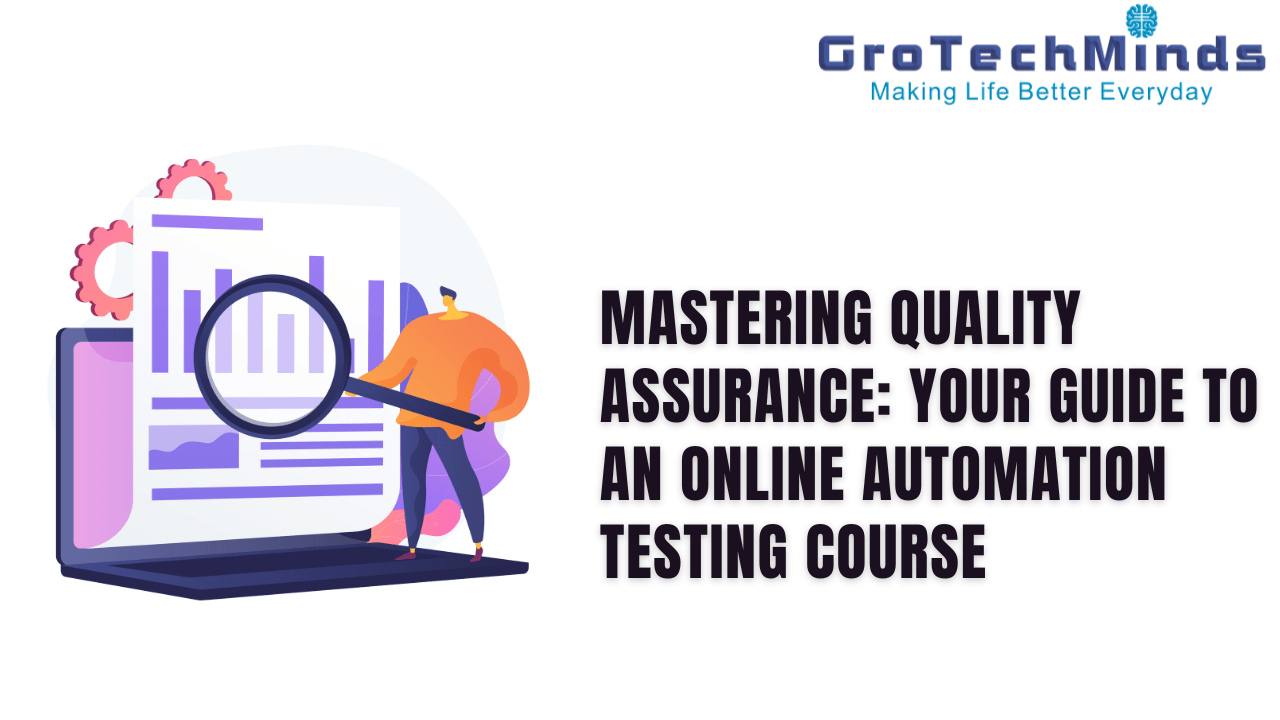online automation testing course
In today’s rapidly evolving world of software development, ensuring the quality of applications is more critical than ever. While manual testing remains an essential component of Quality Assurance (QA), it has its limitations. This is where automation testing comes into play, revolutionizing the QA landscape. If you’re looking to become a proficient QA professional or enhance your testing skills, enrolling in an online automation testing course could be the key to unlocking your success.
The Evolution of Testing:
Traditionally, manual testing involved human testers meticulously executing test cases to identify bugs and issues in software. While effective, this method can be time-consuming, especially with the increasing complexity of modern applications. Automation testing emerged as a solution to address these challenges, leveraging tools and scripts to execute test cases efficiently.
Benefits of Automation Testing:
Speed and Efficiency:
Automation testing significantly accelerates the testing process. Tasks that might take hours or even days with manual testing can be completed in a fraction of the time, allowing for faster release cycles. This speed is crucial in today’s agile development environment, where rapid and frequent releases are the norm.
Repeatability:
Automated tests can be executed repeatedly without fatigue or variation. This ensures consistent and reliable results, especially in scenarios where the same tests need to be run multiple times, such as during regression testing. The ability to repeat tests without errors reduces the risk of overlooking critical issues.
Coverage:
Automation allows for comprehensive test coverage, enabling the testing of various scenarios, configurations, and data sets that may be impractical to cover manually. This broader coverage contributes to higher confidence in the software’s quality. Automation can handle repetitive and data-intensive tasks, ensuring all aspects of the application are thoroughly tested.
Regression Testing:
As applications evolve, changes may introduce new bugs or impact existing functionality. Automation is particularly valuable for regression testing, ensuring that previously developed and tested software still works seamlessly after changes. This helps maintain the integrity of the software and prevents the reintroduction of known issues.
Choosing the Right Online Automation Testing Course:
Comprehensive Curriculum:
When selecting an online automation testing course, look for one that covers a broad spectrum of automation testing concepts and tools. This includes understanding different frameworks (e.g., Selenium, Appium), scripting languages, and integration with Continuous Integration/Continuous Deployment (CI/CD) pipelines. A well-rounded curriculum ensures you acquire the skills needed to address diverse testing challenges.
Hands-on Experience:
Practical application is key to mastering automation testing. A high-quality course should provide ample hands-on exercises and real-world projects, allowing you to apply your knowledge in a simulated environment. This practical experience is invaluable when transitioning to real-world testing scenarios. It not only reinforces theoretical concepts but also builds the muscle memory necessary for effective automation testing.
Industry-Relevant Tools:
Ensure that the course covers widely used automation testing tools in the industry. Familiarity with tools such as Selenium course WebDriver, JUnit/TestNG, and Cucumber can significantly enhance your marketability as a QA professional. These tools are commonly used in many organizations, making your skills easily transferable. Knowledge of industry-standard tools ensures you can seamlessly integrate into diverse development environments.
Certification:
Opt for courses that offer certifications upon completion. Certifications provide tangible validation of your skills and can be valuable when seeking employment or advancing your career. Well-recognized certifications also demonstrate your commitment to staying current in the rapidly evolving field of automation testing. Employers often value certified professionals, considering it a reliable indicator of proficiency and dedication to the craft.
Community Support:
Look for courses that provide access to a community or forum where you can connect with fellow learners, ask questions, and share insights. A supportive community can be an invaluable resource as you navigate the challenges and intricacies of automation testing. Networking with peers allows you to learn from others’ experiences, gain different perspectives, and stay updated on the latest trends and best practices in the field.
Read more about how x*x*x is equal to 2 and get aware of it.
Continuous Learning Opportunities:
Choose a course that emphasizes the importance of continuous learning. Automation testing is a dynamic field, with new tools and techniques regularly emerging. A good course should instill a mindset of ongoing education, empowering you to adapt to changes and stay ahead in your career. Consider courses that offer updates or additional modules to keep your skills current.
Conclusion:
Embracing automation testing is a strategic move for anyone aspiring to excel in the field of Quality Assurance. An online automation testing course offers a flexible and accessible way to acquire the necessary skills and knowledge. By investing in your career today, you can unlock the door to a world of opportunities in software testing and quality assurance.
The benefits of speed, efficiency, repeatability, and comprehensive coverage make automation testing an indispensable skill set in the ever-evolving landscape of software development. Choose a course wisely, commit to continuous learning, and position yourself as a sought-after QA professional in the competitive job market. The advantages of automation testing extend beyond individual career growth—they contribute to the overall success and quality of the software products you help bring to market. As you embark on this journey, remember that mastery of automation testing is not just a milestone; it’s a continuous pursuit of excellence in ensuring the reliability and efficiency of software applications.










